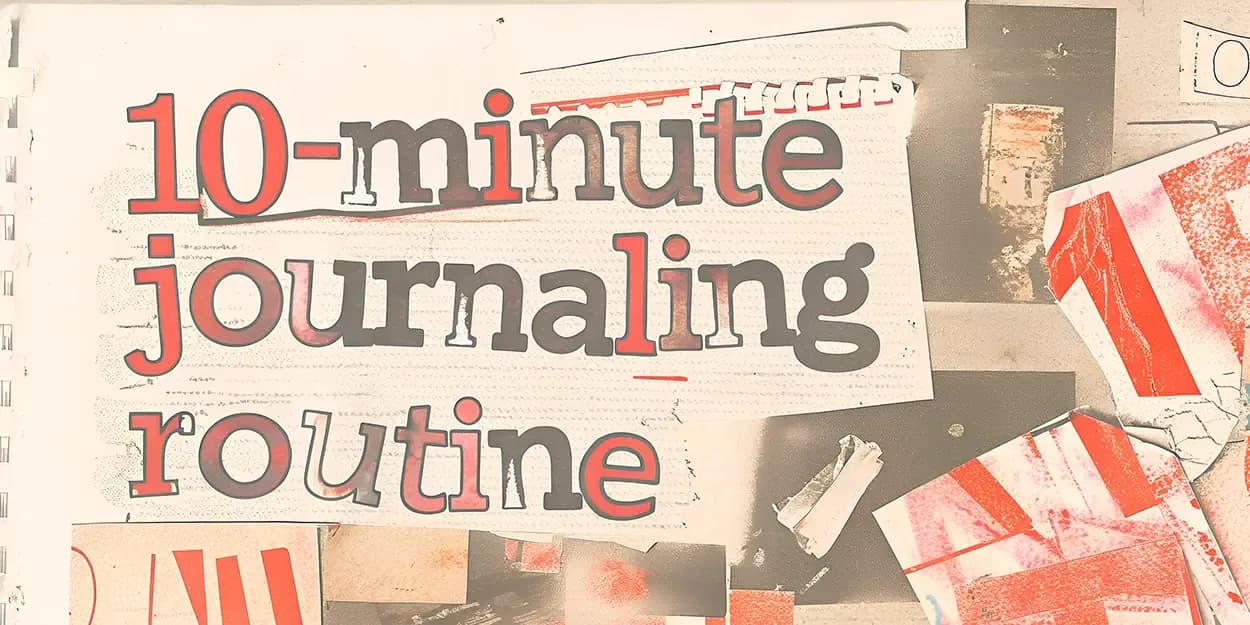Let's be real: finding time for self-care feels impossible some days. Between work deadlines, family obligations, and just trying to keep your head above water, the idea of adding "one more thing" to your day can feel overwhelming.
But here's what I wish someone had told me years ago: you don't need an hour of quiet reflection to experience real benefits from journaling. Research shows that just ten minutes of intentional writing each day can significantly reduce stress, increase emotional clarity, and support a more positive mindset.
I'm sharing a simple three-step routine that's grounded in psychological science and designed to fit into even the busiest days. This isn't about perfection – it's about creating sustainable space for yourself.
Why This Routine Works: The Science Behind It
Before we dive into the steps, let me share why this approach is so effective. This routine combines three evidence-based practices that work together to support your emotional wellbeing:
Expressive writing helps regulate your brain's stress response by activating your prefrontal cortex (the thinking part) while calming your amygdala (the emotional alarm center). When you write about feelings, you're essentially helping your brain make sense of what you're experiencing.
Gratitude practice retrains your mind to notice supportive details in your life, creating what psychologists call a "positive attention bias." Studies show this can increase happiness and emotional resilience.
Mindful intention-setting aligns your nervous system with a chosen emotional tone, helping you handle stress better throughout the day.
Together, these three elements create a powerful foundation for emotional health – all in about ten minutes.
Step 1: Check In and Free Write (3-4 minutes)
Start by writing whatever comes to mind. No filter, no judgment, no trying to sound smart or articulate. Focus on emotional thoughts, worries, or internal tensions that are taking up mental space.
This is often called expressive writing, and it's not about producing something polished. The goal is release – expressing what usually stays unsaid or unprocessed.
Why It Works
James Pennebaker's groundbreaking research on expressive writing has shown consistent benefits across decades of studies: reduced stress, improved mood, strengthened immune function, and enhanced emotional clarity. When you translate feelings into language, your brain literally processes them differently.
Think of it as a mental pressure release valve. Those anxious thoughts that loop endlessly in your head? Writing them down helps your reasoning center take over, quieting those physiological anxiety signals.
How to Do It
- Set a timer for 3-4 minutes
- Write continuously without stopping to edit
- Focus on how you're feeling, what's bothering you, or what's on your mind
- Don't worry about grammar, spelling, or making sense
- If you get stuck, write "I don't know what to write" until something else comes
Step 2: Gratitude and Grounding (3-4 minutes)
After you've released what's heavy, gently shift your focus toward what's going well. This isn't about suppressing difficult feelings – it's about creating balance.
Write about:
- Something that went well recently
- Something or someone you appreciate
- A moment of peace or beauty you noticed
- Something small that made you smile
The Research Behind Gratitude
Studies by researchers Robert Emmons and Michael McCullough found that people who took time to write about things they were grateful for each week showed increased happiness, fewer physical symptoms, and improved overall wellbeing.
Gratitude practice works by strengthening neural pathways associated with hope and contentment. You're not ignoring challenges – you're training your brain to notice the full picture, including what's supportive and nurturing.
Research also shows that implementing a regular gratitude practice can increase emotional resilience, enhance relationship satisfaction, and encourage a more optimistic mindset.
How to Do It
- Aim for 3-5 specific things (quality over quantity)
- Be concrete: instead of "I'm grateful for my family," try "I'm grateful my sister sent me that funny meme this morning"
- Notice small things – they count just as much as big ones
- If it feels forced at first, that's normal. Keep going.
Step 3: Set a Gentle Intention (2-3 minutes)
Close your journaling session by writing one simple intention for your day. These aren't rigid goals or to-do list items – they're supportive reminders about how you want to show up.
Examples:
- "Today, I will choose compassion over pressure"
- "I will move slowly and remain present"
- "I will notice when I need a break and actually take it"
- "I will speak to myself like I'd speak to a friend"
Why Intentions Matter
Research on mindfulness shows that even brief periods of intentional awareness can increase emotional stability and reduce stress responses in daily life. You're essentially setting an emotional tone before your day unfolds.
Mindfulness researcher David Creswell found that small moments of reflective, self-directed intention can strengthen the brain's ability to handle stress and return to calm after emotional activation.
Think of your intention as an internal anchor – something you can return to when emotions and pressure arise. It guides your nervous system toward the state you want to cultivate.
How to Do It
- Write one sentence that starts with "Today, I will..." or "Today, I want to remember..."
- Keep it simple and realistic
- Make it about your internal state, not external achievements
- Read it once more before closing your journal
Making It Stick: Tips for Building the Habit
The most powerful routine is the one you'll actually do. Here's how to make this practice sustainable:
Pick a consistent time. Morning works for many people (it sets the tone for your day), but evening or lunch breaks work too. What matters is consistency.
Keep it low-pressure. Some days you'll write more, some days less. A messy, rambling entry counts just as much as a profound one.
Protect your privacy. Knowing your thoughts are truly private makes a difference. This is where tools with strong encryption become important – you need to feel safe being honest.
Start with just one week. Commit to seven days and notice how you feel. Most people find the benefits show up faster than they expect.
The Bottom Line
This ten-minute routine is powerful not because it takes a lot of time, but because it's consistent, intentional, and grounded in emotional science. It creates space for emotional release and clarity, increased awareness of what's good in your life, and compassionate self-regulation.
You don't need perfect conditions, a beautiful journal, or hours of free time. You just need ten minutes and the willingness to show up for yourself.
Want a secure space to practice this routine? Comma uses zero-knowledge encryption so your journal entries stay truly private – even we can't read them. Your thoughts, your space, your way.


